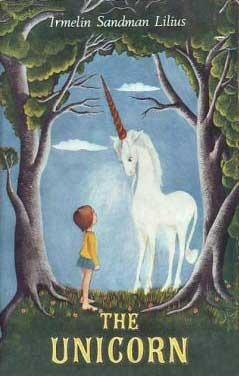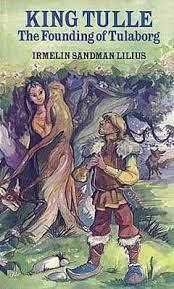Unicorns and Witches: the Forgotten World of Irmelin Sandman Lilius
by Charlotte Berry
Respected and loved across Scandinavia, author and illustrator Irmelin Sandman Lilius (b. 1936) is largely unknown to the current British readership. Sandman debuted as a writer with the poetry collection Trollsång (Troll Song) in 1955 and started writing full-time when she married artist and writer Carl-Gustaf Lilius (1928-1998) and moved to his childhood home in Hanko/Hangö, where she still lives.
Typically placed alongside renowned Scandinavian children’s writers Astrid Lindgren, Maria Gripe and fellow Finland-Swede Tove Jansson, Lilius now inspires new generations of Nordic young adult authors such as Dane Lene Kaaberbøl.

Photograph: Tomi Parkkonen
Lilius is best known for her sequence of novels based on the fictional kingdom of Tulavall, where the borders between reality and the mystical are blurred, where time exists on more than one level and where supernatural figures exist alongside the more worldly. Her innovative and poetic use of language and richness of imagery and symbolism combine with leisurely developing plots and wide casts of characters. Frequently inspired by, and compared with, the Anglo-Saxon children’s fantasy and storytelling traditions, Lilius has a lack of literary profile in the UK which is both surprising and regrettable.
However, a number of the early works of Lilius were indeed published in the UK in the 1960s and 1970s, just as her work was becoming widely appreciated in Scandinavia and further afield. Lutterworth Press in London took on the first two titles from Lilius’ four-part series based on her own daughter Muddle, The Unicorn, 1964, (Enhörningen, 1962) and The Maharajah Adventure (1966, tr. Ian Rodger, ill. Veronica Leo; Maharadjan av Scha-schascha-slé, 1964). These relate the fantastical journeys of little girl Muddle, her doll Aster Pippi and the Lonely Troll down the river to find the unicorns and the Sea Witch, and with newfound friend Rufa and the terrifying Mrs Hunger Weeping to restore the Maharajah to his rightful kingdom. Both books were well received although Lutterworth did not publish the two remaining titles.
Paul Binding, newly arrived as Children’s Editor at Oxford University Press, revived British interests in Lilius in 1975 when he encountered her work at the Bologna Book Fair via her agent at Bonniers. Lilius had recently been awarded the Nils Holgersson Plaque (1972). Binding quickly commissioned detailed reader reports from British-Danish translator Marianne Helweg, already known for her work on the Mrs Pepperpot series for Hutchinson (1959-1973) and for a series of Swedish titles for Burke during the 1960s. Binding was sufficiently impressed to take on the translation of the Fru Sola trilogy (Gullkrona Gränd, 1969; Gripanderska Gården, 1970; Gångande Grå, 1971) which had been published to acclaim in Scandinavia alongside other Tulavall novels. Helweg undertook the first title (Gold Crown Lane, 1976), but her sudden death resulted in Joan Tate taking on the remaining two titles (The Goldmaker’s House, 1976 and Horses of the Night, 1979). The trilogy has as a pivotal focus the impoverished and dysfunctional Halter family, combining a social-realist depiction of late-nineteenth-century life in a small Finnish coastal town with fantastical episodes and sub-plots. The first book relates the plight of the family during the illness of their sailor father whereas the second title explores the adventures of orphan Bonadea who works as a maid at the house of the mysterious alchemist Herr Turiam. The final novel concentrates more explicitly on the social and political unrest within the town of Tulavall and the absence of the girls’ mother.
In common with many other Nordic works for children published in the UK at this time, the trilogy’s original illustrations by Lilius were replaced by those of a British artist, in this case Punch illustrator Jos Armitage (using the pseudonym Ionicus). These were very different in style to those of Lilius, who has illustrated books since 1966 and who is known for her free and whimsical style, making much use of movement and bright colours, as seen in her latest picture book Kapten Krabbes Minne (Captain Crab’s Memoirs). In contrast, Ionicus favoured a more static, restrained, line-based and draughtsman-like approach which Lilius apparently disliked.

Binding left OUP in October 1977 and was replaced by Antony Kamm, who harboured considerably less fascination for (Nordic) titles for children in translation, which remained challenging to sell profitably to a British readership despite the established success of OUP’s Pippi Longstocking titles during the 1950s. As a result, it fell to Pelham Books to publish Lilius’ final UK title, King Tulle: the Founding of Tulaborg (1980). This publishing house had already successfully published a number of Scandinavian children’s authors such as Robert Fisker, Lennart Hellsing, Gunnel Linde, Svend Otto S. and Ole Lund Kirkegaard and hoped to capitalise on the success of the Fru Sola trilogy.
Since the 1970s, Lilius has generated an extensive range of works, continuing the Tulavall sequence and within it her interests in urbanisation, social class and the role of women, as well as self-illustrated (and partly autobiographical) children’s picture books. Adult titles include the Främling quartet (The Stranger quartet,1980-1990) with the first title Främlingsstjärnan (Stranger’s Star) positively reviewed in SBR’s forerunner Swedish Books in 1980. The review was by American translator Sheila La Farge, and was accompanied by an extensive translated extract by Tate. The literary innovation, merit and appeal of Lilius has since been recognised in the shape of the award of the Topelius Prize (1980) and the Tove Jansson Award (2003). Her characteristically unusual interplay of everyday reality with myth, history, folk tradition and family legends combine to create a highly original atmosphere which would undoubtedly appeal to a British audience brought up on a healthy dose of C. S. Lewis, J. R. R. Tolkien, Alan Garner, Penelope Lively and J. K. Rowling. I certainly hope in future years that the unicorns and witches of Lilius will become inspirational to an Anglo-Saxon audience on the other side of the North Sea.

Irmelin Sandman Lilius is a Finland-Swedish author and illustrator. She has written novels for children and adults, as well as poetry.
Charlotte Berry is a curator and archivist.
This article is partly based on an unpublished PhD thesis, ‘Publishing, translation, archives: Nordic children’s literature in the United Kingdom, 19502000’, University of Edinburgh, 2013, which drew extensively on the archives of Oxford University Press.
Author's acknowledgements: My thanks to Paul Binding and Irmelin Sandman Lilius for answering my many thesis-related questions, and to Claire Dickenson (FILI/ UCL), Päivi Nordling (Finnish Institute for Children’s Literature) and Anne Kristin Lane (Nasjonalbiblioteket, Oslo) for their help in sourcing secondary literature from Scandinavia for this article.
